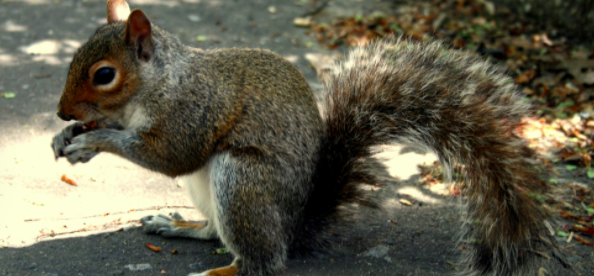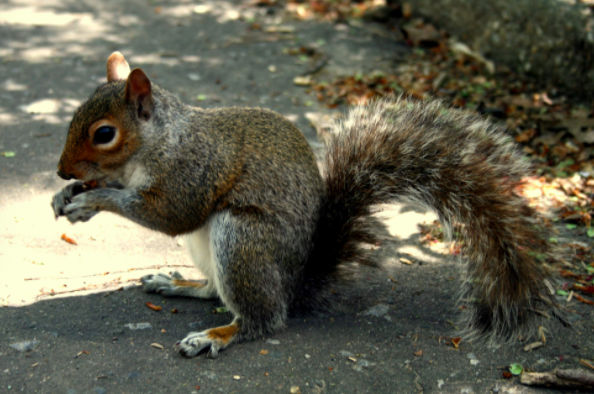The Squirrel in the Park


Pictured above is a squirrel. The squirrel is in Manhattan’s Central Park, an expansive natural escape in the middle of one of the world’s most prominent cities. Central Park has lots of squirrels — certainly too many to count. (As of 2012, per the New York Times, “no formal census [was] being considered.) But… how did all those squirrels get there? And why?
Because they’re exotic. Or, were.
Central Park is, unsurprisingly, located in the middle of Manhattan. On all four sides, the park is bound by Manhattan’s well-travelled roadways, filled with cars and bikes and pedestrians — hardly a hospitable environment for a squirrel. While it’s possible that the first squirrel (or squirrels, as it takes at least two to start a population) crossed 59th Street, found itself some acorns, and made itself a cozy little home, that creates a second problem: how’d it get to 59th Street in the first place? Manhattan is an island and, while squirrels can swim, it’d be quite the effort. And no, Central Park’s squirrels don’t predate Central Park.
Squirrels are indigenous to North America and, in the early 1800s, were common on the island of Manhattan. The rapid development of the city proved to be incompatible with any efforts (of which there weren’t any) to maintain the rodents’ habitat, though. By the 1850s, squirrels were quite rare in Manhattan, so much so that in 1856 — a year before Central Park’s founding — one of them literally stopped traffic. New York magazine relays an account from the now-defunct New York Daily Times when passersby happened upon a squirrel: “The appearance of an ‘unusual visitor’ in a downtown tree attracted hundreds of cheering rubberneckers, who had to be dispersed by cops.”
New Yorkers were hardly alone in their enraptured love of this “new” creature. Gizmodo expands on the popularity of the squirrel and its novelty:
Around the same time, a sea change in our relationship with squirrels was already underway in Philadelphia. The city had released three squirrels in Franklin Square in 1847 and had provided them with food and boxes for shelter—and the people loved it. One visitor is quoted as saying “it was a wonder that [squirrels] are not in the public parks of all great cities.” In the years that followed, the trend spread to Boston and New Haven, where squirrels soon grew so fat from humans feeding them that they were falling out of the trees. Cities even started planting nut-bearing trees so that the squirrels would have their own food source.
New York itself was soon to follow. In 1877, the city imported a few dozen pairs of squirrels into the park, gave out peanuts to parkgoers so they could feed the creatures, and even provided housing in the form of nesting boxes. (Those are basically bird houses, but for squirrels. Here are a few on Amazon, if you want to see the pictures.) As one would correctly guess, the squirrel population boomed, and — despite that lack of a formal census — Central Park found itself with way, way more squirrels than anyone intended.
So in 1883, again per New York magazine, “the city organize[d] a series of early-morning squirrel hunts for population control.” The ASPCA and others objected, but those objections didn’t matter — the squirrels were going to win anyway, as their numbers were simply too high for such an informal method of culling its numbers. Ultimately, hunting squirrels became illegal. Instead, communities — Central Park included — began to see the act of feeding the squirrels as a simple way for people to connect with nature. As Gizmodo simply sums it up: “they were put there to remind us of how man and nature must get along, even if it takes a little effort.”
Bonus fact: As the above-linked New York Times article notes, the squirrel population in Central Park fluctuates a lot, due to a variety of factors — “the availability of food, water and shelter; predation; illnesses; and the number of young” is an incomplete list. An abundance of acorns in 1967, though, led to something strange in 1968: a lot of dead squirrels in areas that don’t typically have a lot of live squirrels. The phenomenon, called “the Great Squirrel Migration” and summarized by the University of Maryland’s library, occurred when a lot of squirrels traveled outside their typical range in hopes of finding new places to store their bounty of acorns. But, per the Maryland library, “because the squirrels did not know the geography of the new areas, [many] unknowingly ran to their doom in busy roads and bodies of water.” Yikes.
From the Archives: The Tales of the Prairie Dog: The squirrels’ cousins have their own stories.
Related: A collection of squirrel nesting boxes, in case you missed it above.
Squirrel image via here.
